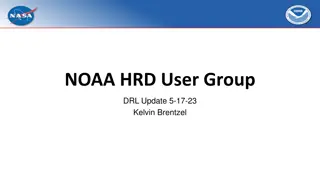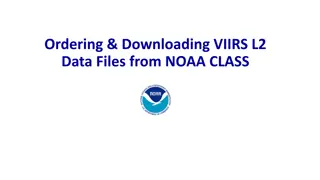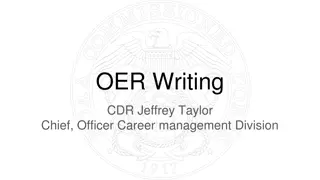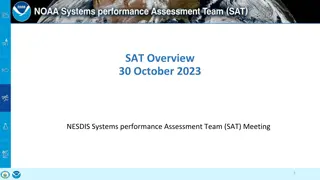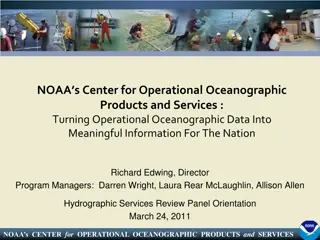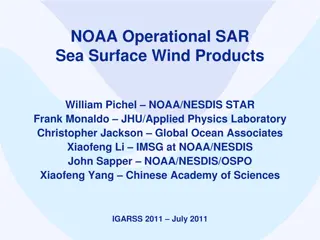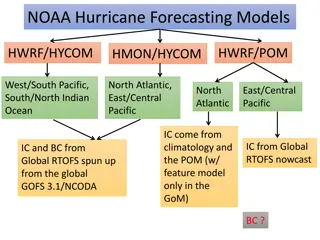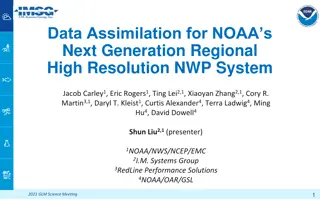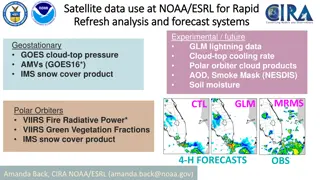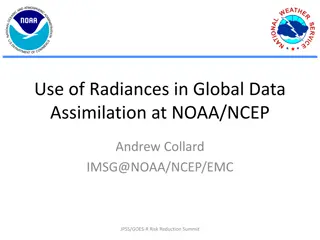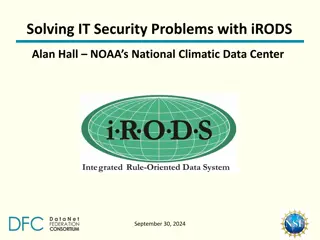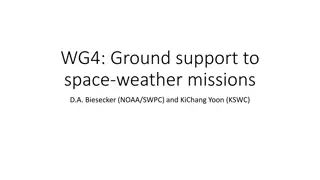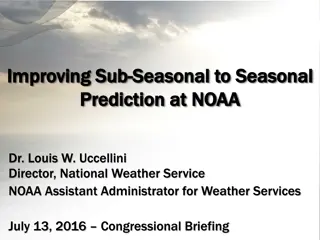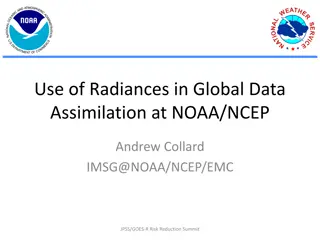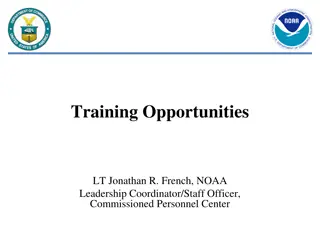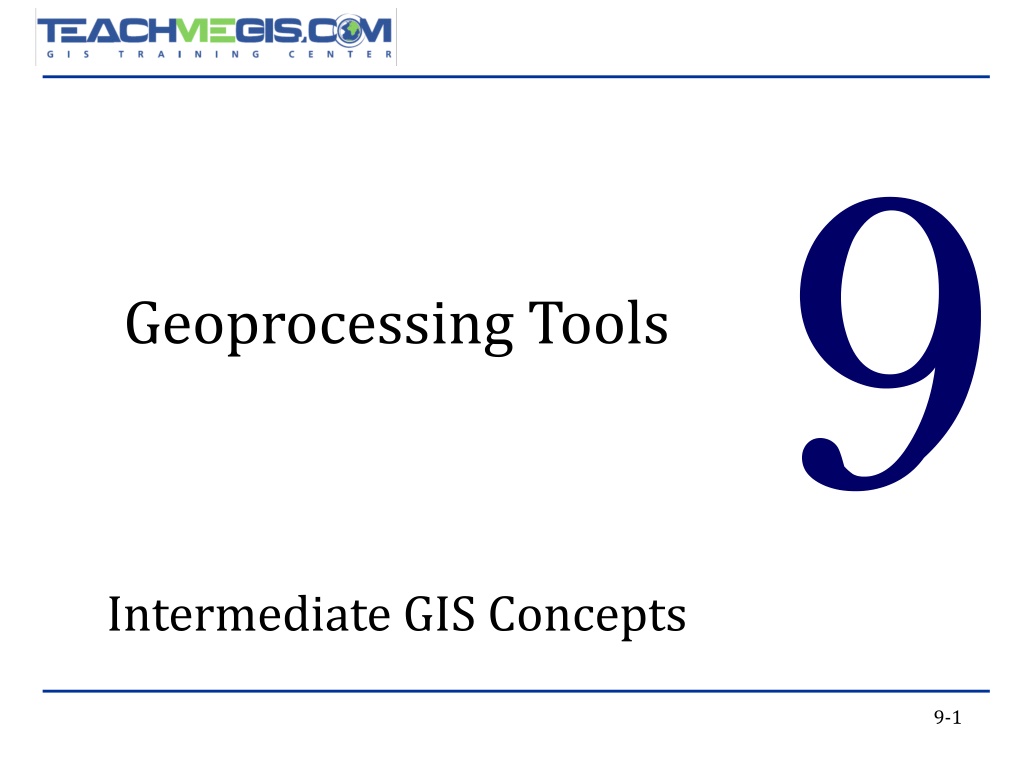
Understanding Geoprocessing Tools for GIS Problem Solving
Explore intermediate GIS concepts and ArcToolbox options to effectively solve various problems in GIS, from emergency planning to market analysis. Learn how to access and utilize ArcToolbox tools, search for specific tools, and find tool help resources. Discover common geoprocessing tools and understand functions like intersecting feature classes.
Download Presentation

Please find below an Image/Link to download the presentation.
The content on the website is provided AS IS for your information and personal use only. It may not be sold, licensed, or shared on other websites without obtaining consent from the author. Download presentation by click this link. If you encounter any issues during the download, it is possible that the publisher has removed the file from their server.
E N D
Presentation Transcript
Geoprocessing Tools Intermediate GIS Concepts 9-1
Chapter Overview Geoprocessing Tools Solving Problems in GIS ArcToolbox Geoprocessing Options 9-2
What Kinds of Problems? Etc. Emergency Planning Crime Patterns Market Analysis Site Suitability Planning 9-4
Example Workflow Planned Highway Expansion: Find properties within the expansion area and determine the total value commercial and residential to see potential expenses Select properties that intersect the buffer Summarize selected properties on zoning code View total property values in the sum table Buffer highway 9-5
ArcToolbox 9-6
ArcToolbox Access from Standard toolbar Dockable Contains: Toolboxes Toolsets Tools Models Script tools 9-7
Search for Tools Search window Tools filter Search by tool name Click to open tool or help 9-8
Finding Tool Help From ArcToolbox In the ArcGIS Help: Geoprocessing Tool Reference 9-9
License Levels Tool availability depends on license Basic, Standard, Advanced Show locked tools Hidden by default Help 9-10
Geoprocessing Menu Commonly used tools can be accessed straight from the geoprocessing menu Additional resources Search for tools Results Options Environments 9-11
Intersect Combines two or more feature classes Keeps attributes from each input feature class Works for points, lines and polygons Only areas common to all input feature classes are included in the output 9-12
Union Combines two or more feature classes Keeps attributes from each input Empty attributes where no overlap Works for polygons Areas from all inputs are in the output 9-13
Dissolve Merges features based on matching attributes Creates new feature class Option for statistics on numeric columns Examples: Dissolve zip code polygons on city name attribute to create city polygons Dissolve contour lines on the Z-value to remove unnecessary pseudo nodes 9-14
Merge Appends feature classes Combines attributes Creates new output feature class Example: Combine three days of data gathering into one single feature class 9-15
Geoprocessing Options Overwrite output Warning instead of error when populating tools Background processing ModelBuilder Prompt for parameter Results Management Keeping too many results will slow down ArcMap 9-17
Environments Set Environment variables, such as current workspace and scratch workspace Environment settings affect all tools 9-18
Results Access to all messages resulting from running tools Shows how tools were previously run Right-click Open to re-run a tool with the same settings Generate a Python code snippet 9-19
ModelBuilder Use ModelBuilder to: Create custom tools in ArcToolbox Automate tasks Easily test alternate scenarios Document workflows 9-20
Python Where can you use it? What is Python? What can it do? Free scripting language Object oriented Easy to learn, easy to use Simple syntax rules Lots of users across the globe ArcGIS Geoprocessing commands Anything found in ArcToolbox System tools Models Script tools Python window Add scripts to ArcToolbox Python Parser: Label expressions Display expressions Field Calculator 9-21
More Tools to Consider Feature To Polygon Creates a feature class containing polygons generated from areas enclosed by input line or polygon features. 9-22
More Tools to Consider Points to Line Creates line features from points. 9-23
More Tools to Consider Add XY Coordinates Adds the fields POINT_X and POINT_Y to the point input features and calculates their values. It also appends the POINT_Zand POINT_M fields if the input features are Z- and M-enabled. 9-24
More Tools to Consider KML to Layer Converts a KML or KMZ file into feature classes and a layer file. The layer file maintains the symbology found within the original KML or KMZ file. Learn more about KML support in ArcGIS http://desktop.arcgis.com/en/arcmap/10.3/manage- data/kml/what-is-kml-.htm Data Conversion Toolbox 9-25
More Tools to Consider Generate Near Table Calculates distances and other proximity information between features in one or more feature class or layer. Unlike the Neartool, which modifies the input, Generate Near Table writes results to a new stand-alone table and supports finding more than one near feature. 9-26
More Tools to Consider Table to Ellipse Creates a new feature class containing geodetic ellipse features constructed based on the values in an x-coordinate field, y-coordinate field, major-axis field, minor-axis field, and azimuth field of a table. 9-27
Chapter Review Geoprocessing Tools Solving Problems in GIS ArcToolbox Geoprocessing Options 9-28
Exercise 9 Geoprocessing Tools 9-29

